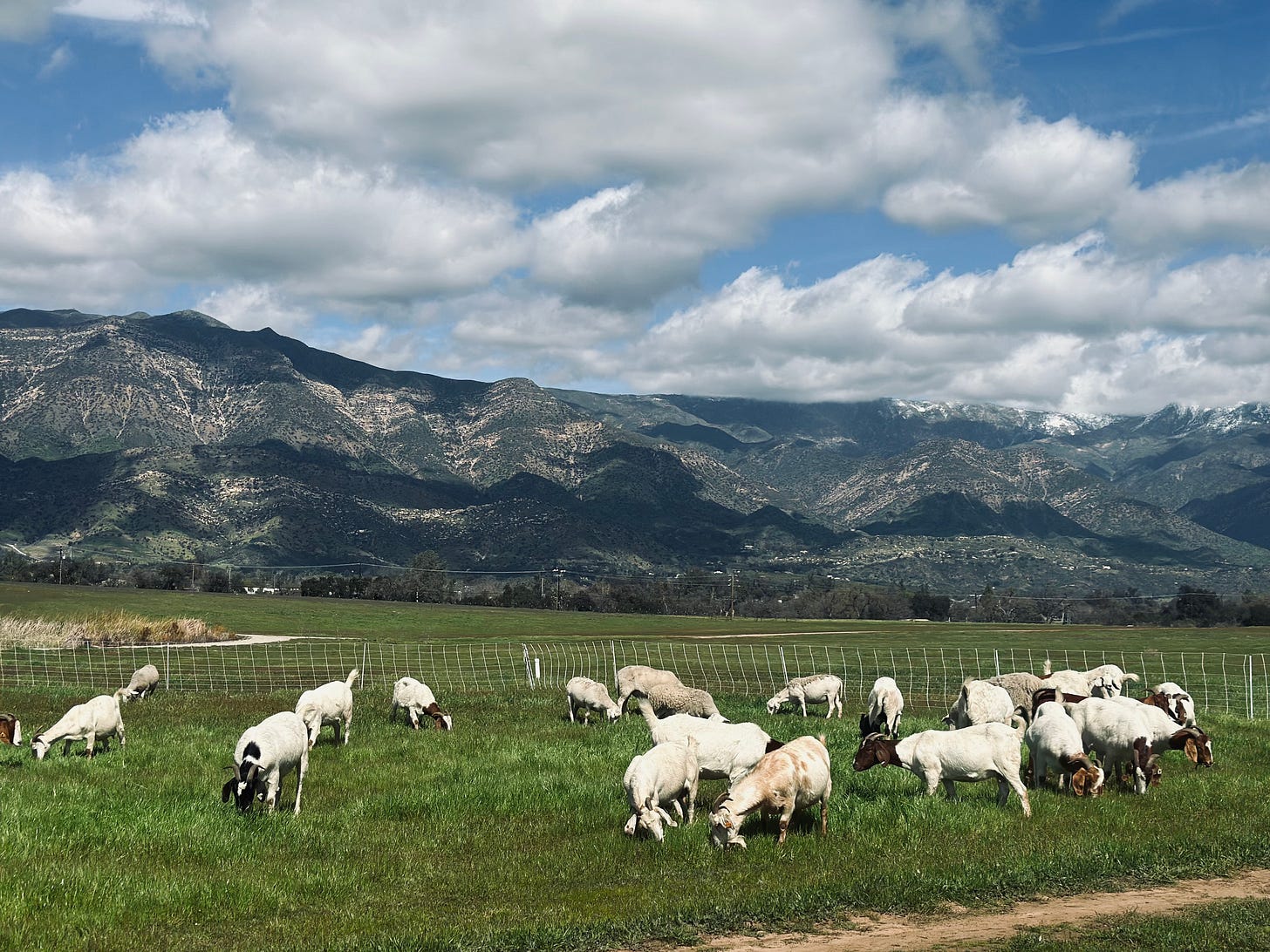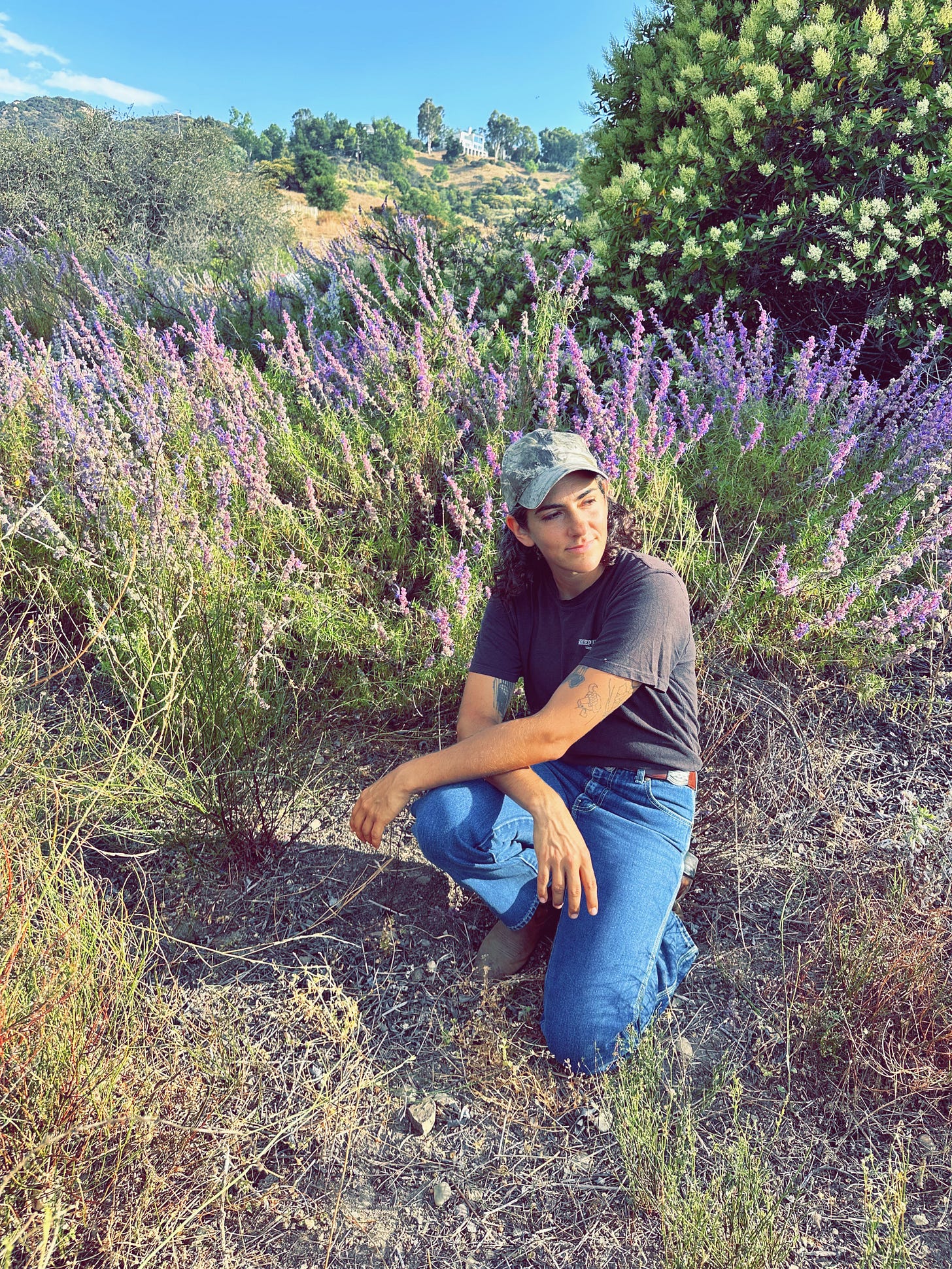This post kicks off a series documenting my experiences shepherding on a prescribed grazing contract in southern California. Notes from the Paddock is the observations that go everywhere and nowhere in particular; it’s the tangled threads of specific moments in time and place; it’s the deep unveilings of the mundane that characterize my life with sheep.
A paddock is an enclosed area in a field that holds livestock. Paddocks can feature permanent hard fencing or, as is the case in my context, can be temporary with the use of solar-powered electric netting.
I am typically against enclosure.1 But when I think of the electric fence borderlines that we shepherds erect to manage the rate of grazing of our sheep and goats, I think less of enclosure and more of the potential that lies in the concept of boundary. While digging electric fence into the dirt of southern California, I think of the planet Saturn’s relationship to boundary, which advocates for limit and structure as a means to achieve longer-term positive impacts elsewhere. Saturn is the planet in astrology and myth that helps us incorporate healthy boundaries into our lives so that we may have the capacity to be expansive and to grow in other areas, to grow other spaces. This is how I feel about the 2-acre enclosures I create on the vast ocean hillsides of Topanga Canyon - these paddock enclosures limit the movement of the herd so that the land can have time and space to grow and expand. To take a breath.
We use temporary electric net fences to create paddocks in order to mimic the migration patterns of wild ungulates (hooved mammals) who consistently move across the landscape due to pressure from predators like wolves, mountain lions and coyotes. Though context-dependent, wild herds do not typically stay in one place for very long, granting grasslands moments of rest and rejuvenation after periods of grazing. Grasses and ruminant animals evolved in tandem and need each other in order to thrive, but without proper boundaries in place, grasslands can suffer. The temporary enclosure with electric fence is thus the boundary that supports a more holistic, longer-term growth and renewal.
It's 7:20 Monday morning in mid-July. The herd has settled into their first rumination period of the day after waking to graze around 5:40. The sunlight is still faint as it breaches the swaths of ocean clouds emerging from the vast Pacific towards Santa Monica. I gazed upon this exact scene just twelve hours ago, city lights twinkling like sentient eyes in the fog of sunset as the sheep and goats positioned themselves in a tight, shaggy mass in their chosen bedding area. The sheep are stationed loosely this morning at the top of the paddock, all 93 of them in various stages of rest and digest. Sheep are ruminants, carrying four chambers with four separate duties in their bulging stomachs. One of those duties is rumination, the process of regurgitating vegetation, or chewing cud, so that it may be fermented and further broken down into digestible protein for their hearty bodies to use.
The serenity of sheep deep in rumination, angular snouts cocked towards the warmth of the rising sun, is perhaps the greatest force that compels me to continue this work of herding animals across the landscape. They chew with machine-like jaws moving in a circular motion, some with gently closed eyes, meditatively soaking up the sea breeze. Their muscles vibrate in response to the landing of an occasional fly, the hordes of irritants not quite fully enlivened until the heat of the day sets in.
The air smells woody and vegetal with a slight floral cadence that penetrates deep into my frayed nervous system. The sages lend a spicy, pungent quality to the breeze while a mystery shrub imparts the aroma of citronella candle and lemon verbena. Hummingbirds twist and turn and dip and dive in and among the woolly bluecurls and purple sage blossoms, stopping to imbibe the nectar of the gods. Have you ever put your nose to a woolly bluecurl at the height of its summer season? I heard a child recently exclaim that its fragrance is “just like honey,” reminiscent of the sweetest, brightest blue Kool-Aid. And indeed, the surreal blue of this furry flower is phantasmagoric in sight and scent, truly Willy Wonkan in the felicitous delight it embodies.
Woolly bluecurls, like these tenacious sheep, thrive in arid landscapes with very little moisture. They have developed over millennia to prefer a crackled and parched life in the harshest of climates, awe-inducing in their penchant for germinating dazzling and lush blossoms despite a lack of the vital water element. Their flowering parts stand in for the wool that our hair sheep, who molt their wool every summer, lack, a delicious fuzz that if woven into yarn would satisfy any fiber enthusiast.
The livestock guardian dog, Nala, naps languidly as the sun crests the western ridge, her evening job of protecting the herd from predators complete. Her butterscotch fur heaves peacefully up and down in a rhythm deeply calming and reassuring. Though counterintuitive, Nala’s slumber is a signal that the sheep are safe, that no predators lurk on the edges. In winter, she curls herself into a perfect ball, sometimes invisible in the brush and high grass, but today, with mild temperatures and a sunlight healing rather than oppressive, she splays herself long and horizontal, imperceptibly canine amongst her ovine community.
Some sheep lie in this formation, too, heads and necks flat against a ground worn thin by their nightly bedding. Every evening they roll back another layer of soil sheet in their bedding spot, leaving behind fertilizer for next season’s perennials to flourish. Some have speckled faces, spots sometimes confused for dirt and dust. Others are all white with patches of wool that hasn’t yet molted for the season. Some stay together with other sheep they know well while others prefer to remain slightly separate, allowing the breeze to access every pore of their being.
Gazing upon the wild blue, I find myself tapping my fingers to a rhythm in my head on the plastic arms of my lawn chair. It’s been over a decade since I’ve listened to “Just Like Honey” from Jesus and Mary Chain’s Psychocandy, a record that heavily informed my drumming style during some wayward years at the start of the 2010s, and yet somehow the shambolic beats are still embedded in my limbs. That record was like honey in the complex beehive of my ears back then, a sweet salve to soothe the achingly long process of healing a broken foot, bones misshapen from taking a fall on a skateboard coming home from my shift as a counselor at the Berkeley free clinic. I’ve since replaced the four wheels of a skateboard with an ATV and Scottish shoegaze music with the soundscape of sheep grazing, but I’m captivated still by muscle memories that a sweet floral confection in the field can awaken after a decade of dormancy.2
Enclosure is the process of transforming commonly-held and stewarded lands (often used for grazing and other agricultural pursuits) into privately-owned, fenced-off plots. Enclosure in Europe during the middle ages and through the Industrial Revolution had a huge influence on many European peoples’ disconnection to land and animals as the movement forced migrations of agrarian peoples to cities of industry for work. More on enclosure to come but for now, check out Silvia Federici’s Caliban and the Witch, which dives into the intersections of gender, enclosure and the transition from feudalism to capitalism in Europe.
The mind wanders to inexplicable corners and crevices while watching sheep, and this deep memory is the first of many examples of this criss-crossing and intertwining. My Notes from the Paddock series is about documenting what happens in these moments of rest and stillness.





